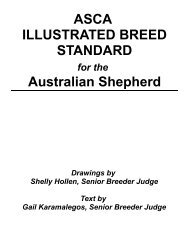2018 May June
Create successful ePaper yourself
Turn your PDF publications into a flip-book with our unique Google optimized e-Paper software.
Officer Reports<br />
Who is affected: ASCA Business Office and the ASCA System<br />
Effective date: Immediately upon approval by the Board of<br />
Directors<br />
Bryant left the meeting at 6:37 p.m.<br />
DIRECTOR’S HANDBOOK<br />
The Board has been working to update the Director’s Handbook.<br />
There was some discussion as to whether Dock Jumping should be<br />
included in the list of events to be held at the National Specialty.<br />
It was decided to remove the entire listing of events and change<br />
the wording to be all inclusive. The topic of Dock Jumping at the<br />
Nationals will be revisited.<br />
2017 FINALS FINANCIAL REPORT<br />
DeChant presented the 2017 Finals Financial Report. The 2017<br />
ASCA Consortium is not requesting any additional funds for the<br />
Finals. They spent more on judges and receptions than was budgeted<br />
but are not requesting reimbursement.<br />
BD.18.24 2017 Finals Financial Report<br />
Motion by King to accept the 2017 Finals Financial Report as<br />
presented. Second by Vest.<br />
Approve: Busquets, Creelman, DeChant, Gray, King, Roberts, Vest<br />
Oppose: 0<br />
Abstain: Gibson<br />
Absent: Silveira<br />
Motion carries.<br />
JUDGES’ EDUCATION<br />
Gibson has been researching tools for the Board to use in<br />
implementing judges’ education. She has found that Google<br />
Classroom would serve our purpose, and at no cost. There is<br />
remaining research to be done, however.<br />
DeChant adjourned the meeting at 7:00 p.m.<br />
26 AUSSIE TIMES <strong>May</strong>-<strong>June</strong> <strong>2018</strong><br />
Working Description of the Australian Shepherd<br />
INTRODUCTION<br />
The Australian Shepherd was developed in the 19th and 20th centuries as a general-purpose ranch and farm dog in the American West, where a tough, enduring,<br />
versatile stockdog with an honest work ethic was required. His usual work included moving very large herds of sheep and cattle from summer to winter grazing<br />
grounds and back, flushing range cattle out of heavy brush, and moving livestock in tight quarters such as chutes and alleys. These kinds of jobs are still where<br />
Australian Shepherds excel and are most valued.<br />
The Australian Shepherd is categorized as one of the Loose-Eyed breeds of stockdogs. He is a confident, authoritative worker with a unique style that differs from<br />
Strong-Eyed breeds. He is agile, upright and close-working, and exhibits these distinctive traits while maintaining the ability and versatility to control all types of<br />
livestock in an efficient and deliberate manner.<br />
The Australian Shepherd excels at controlling large and/or slow-moving flocks of sheep and herds of cattle, and is highly regarded for his superior ability to effectively<br />
manage livestock in tightly confined spaces. The Australian Shepherd is powerful and intense by nature easily learning the appropriate force and distance needed<br />
for the type of livestock being worked. Utilizing a loose-eyed approach to stock, a working Australian Shepherd will often display wear, grip, and/or an authoritative<br />
bark, as well as eye when necessary, to handle their stock.<br />
WEAR<br />
The Australian Shepherd’s wear is smooth, balanced, and ground covering as the dog moves easily from side to side at the back of the stock, keeping his herd or<br />
flock together and moving forward. This is a very natural movement for an Australian Shepherd, and one that he can continue doing for hours at a time.<br />
GRIP<br />
The Australian Shepherd will only use grip to move reluctant or challenging stock. The ideal Australian Shepherd naturally grips at both the head and heel, coming<br />
in low and hard on the heels to move cattle, or going to the head and gripping the nose or poll to turn an animal back to the herd.<br />
BARK<br />
The Australian Shepherd may bark to move stock or to face a challenge. His bark is conservative and should be authoritative when used. While the Australian<br />
Shepherd’s grip typically affects a single animal, his bark can influence a whole herd, and is most effective when stock has come to a standstill such as in crowded<br />
alleyways. The Australian Shepherd’s bark is particularly useful when gathering cattle from thick brush.<br />
EYE<br />
Since the Australian Shepherd is a loose-eyed working dog, he prefers to use his authority and presence to move livestock. However, if challenged, he may use eye<br />
in a direct and deliberate way until the challenge is over.



